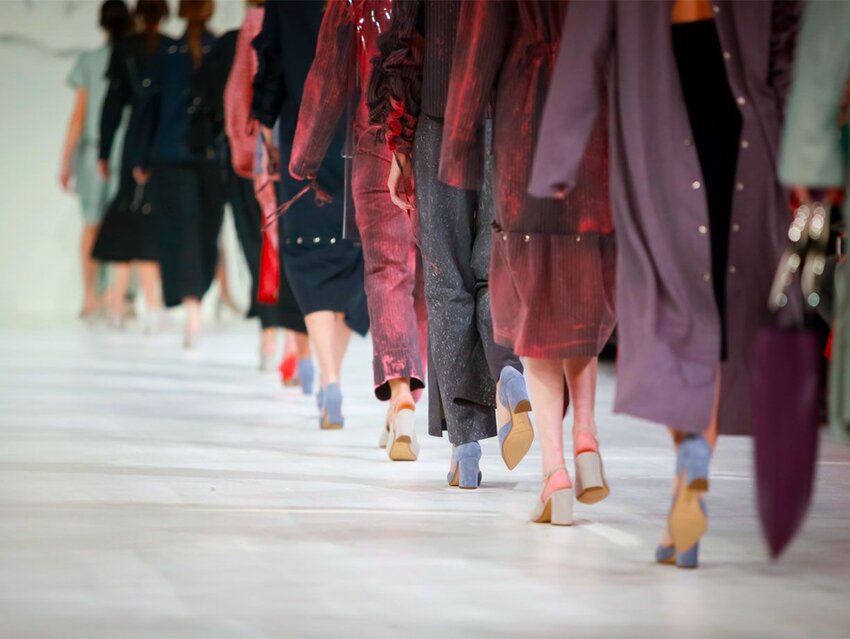In the morning when you stand in front of your closet, assessing which pair of pants matches which shoes or which combination of items to wear, do you ever think about the language of the garments? Even the least stylish of us are subject to the whims of the fashion industry. As Miranda Priestly (played by Meryl Streep) said of the notorious cerulean sweater Andy (Anne Hathaway) wore in The Devil Wears Prada, “You think that you’ve made a choice that exempts you from the fashion industry when, in fact, you’re wearing a sweater that was selected for you by the people in this room.”
The fashion magazine editors in the movie ended up at Paris Fashion Week, and perhaps unsurprisingly, the etymology of much of the fashion lexicon comes from French — très chic! Let’s embrace our inner Miranda Priestly and examine some of the lingo behind fashion.
Couture
“Couture” refers to the design and manufacture of fashionable clothes made to a client’s specific requirements and measurements, as opposed to “ready-to-wear,” which implies the clothing was produced in universal sizes. One step above “couture” is “haute couture,” which implies a certain level of luxury — “haute” translates directly from the French word for “high.” “Couture” appeared in 1908 from the French couture (literally “dressmaking, sewing”), which comes from the Latin consuere, which means “to sew together.” In the fashion world, “couture” generally refers to women’s high-end fashion designers collectively, as in “we’re going to New York Fashion Week to see the couture collections.”
Peplum
A peplum is “a ruffle or flared section in the construction of a jacket or blouse that extends a short distance below the waistline.” The word originated in the Greek peplos, which was an outer robe or shawl worn by Greek women in the classical period until around 300 CE. In more modern usage, “peplum” appeared in the British society publication Queen in 1866: “No dressy afternoon toilette is now considered complete without a peplum.”
Minaudière
This is an evening bag — specifically ornamented with jewels, worked metal, or other decorative techniques — to be held directly in the hand or by a short chain. It comes from the French minaudière, meaning “affected, coquettish,” which implies a certain femininity or delicacy. Its usage in this context appeared around the 1940s. A description in the Springfield, Massachusetts, publication Shopping News detailed the minaudière as such: “Rectangular in shape, the minaudière opens to disclose a good size mirror; there are also five lidded compartments — for powder, rouge, and eye shadow, money, keys, cigarette lighter and tortoise-shell comb.”
Gusset
A gusset is a small piece of diamond-shaped fabric that is typically sewn into the underarm of a sleeve or the crotch of pants — really any area of clothing that fits tightly and is subject to stretch in order to provide additional width, strength, and flexibility. With a gusset, these seams are less likely to tear. “Gusset” first appeared in English in the early 14th century, from the Old French gosset, meaning “armhole; piece of armor for the armpit.” While it was originally armorer jargon, it began to appear in fashion dialogue around the mid-1500s.
Empire Waist
This term refers to a waistline that’s just under the bustline, as in the dresses seen on Netflix’s Bridgerton. While fashion insiders usually pronounce this “ahm-PEER,” instead of with three syllables (as in “historical empire”), the name for this style comes from the high-waisted fashions made popular during the early 19th-century reign of French Emperor Napoleon Bonaparte.
Dart
In fashion, a dart is any V-shaped tuck sewn into a garment to ensure it fits properly at rounded parts of the body, such as the bustline, shoulder, waist, and hip. Think of the famous Jean-Paul Gaultier bra Madonna wore during the Blonde Ambition tour for an example of (very exaggerated) darts. One of the earliest fashion usages dates to an 1884 journal for dressmakers: “To sew the Darts (or Breast Plaits) commence at the top, holding both edges even for one inch.”
Bias Cut
“Bias cut” refers to the diagonal direction of a woven fabric — fabrics tend to stretch more in the bias direction than lengthwise or widthwise, which designers manipulate to ensure garments fit the body more closely or drape into soft folds. While other designers used the bias cut in their garments before him, it was Halston who made the concept iconic in his 1970s collections (think of the flowing halter dresses seen on celebrities such as Bianca Jagger, Liza Minelli, and Iman, coming out of Studio 54).
Featured image credit: Goran Jakus Photography/ iStock

